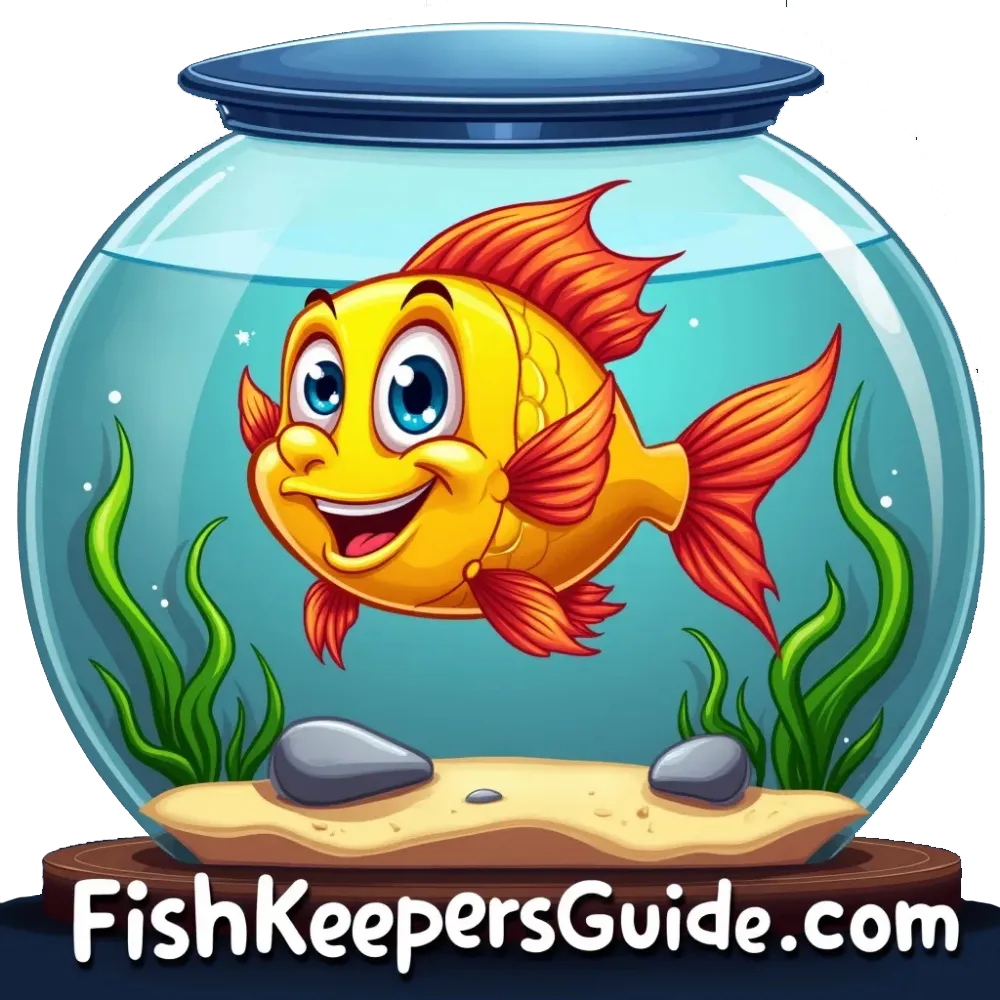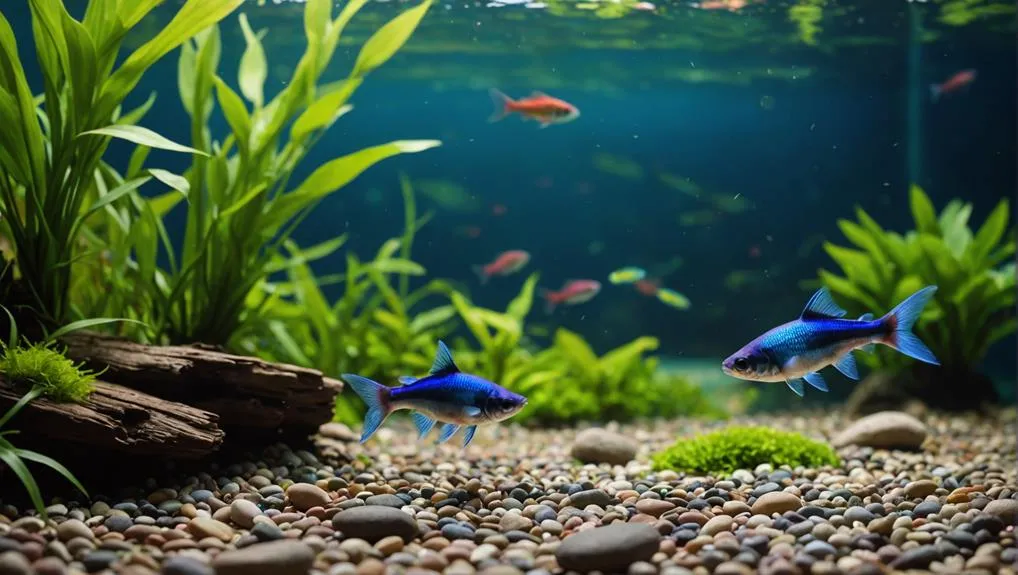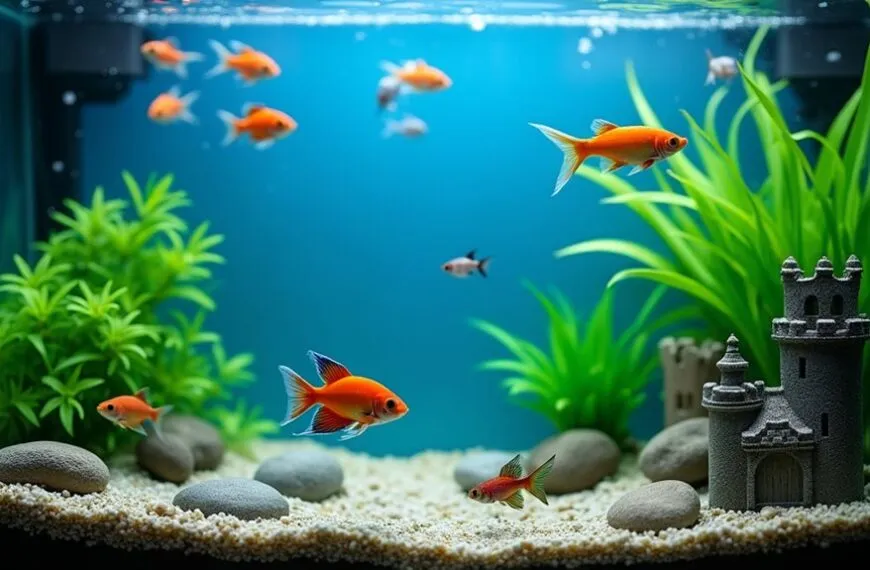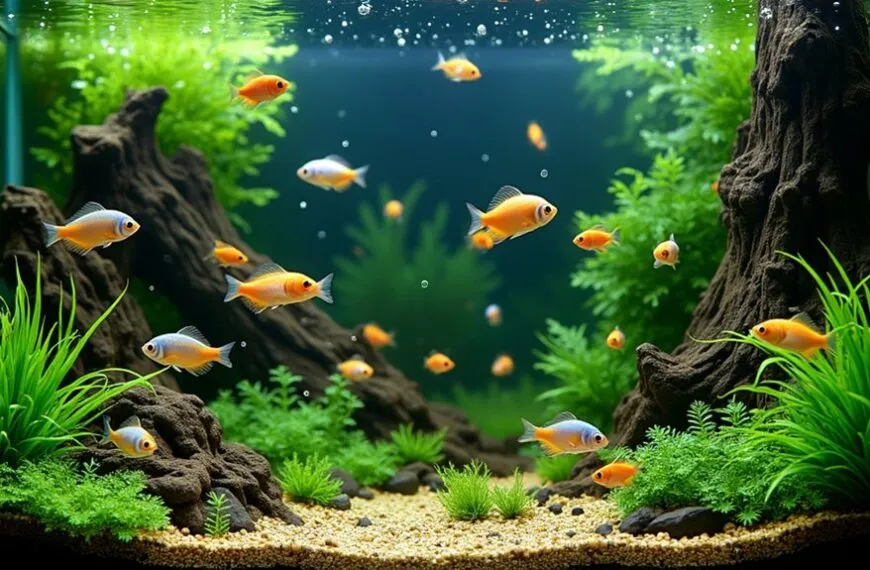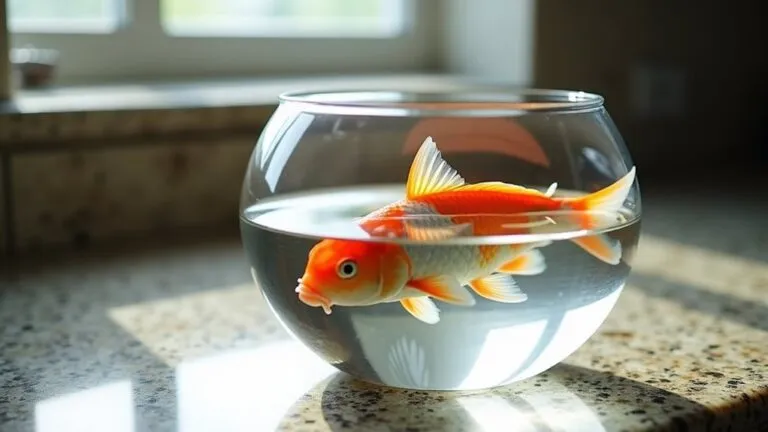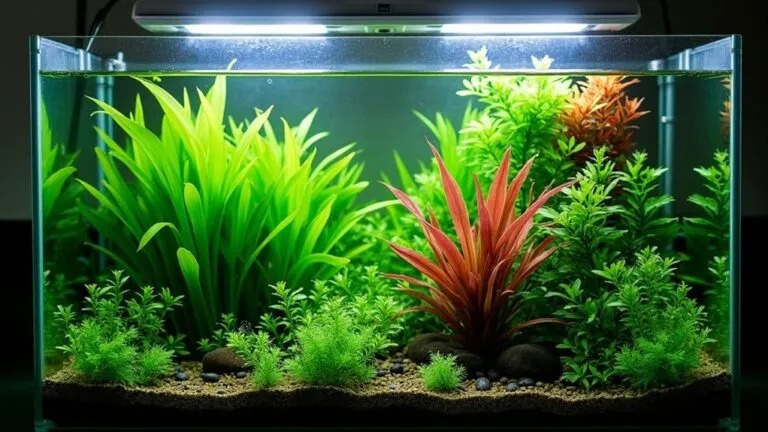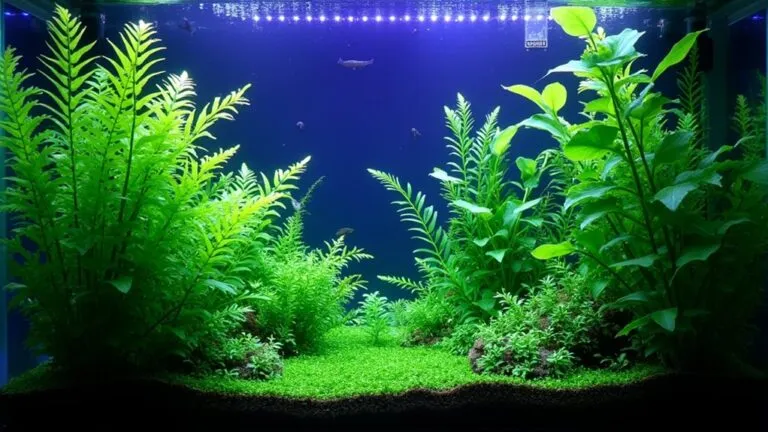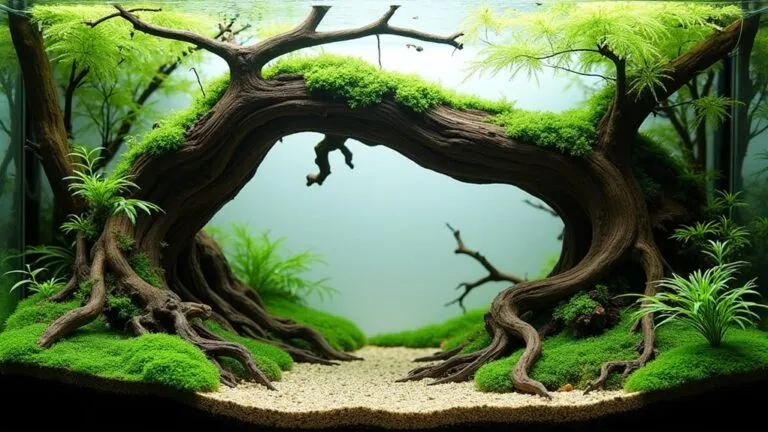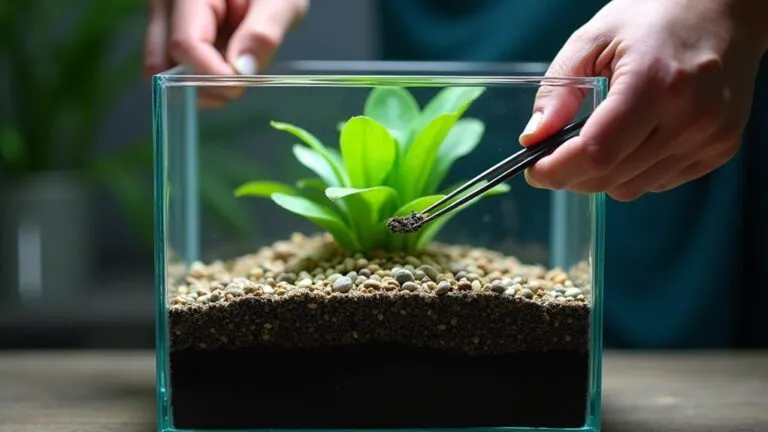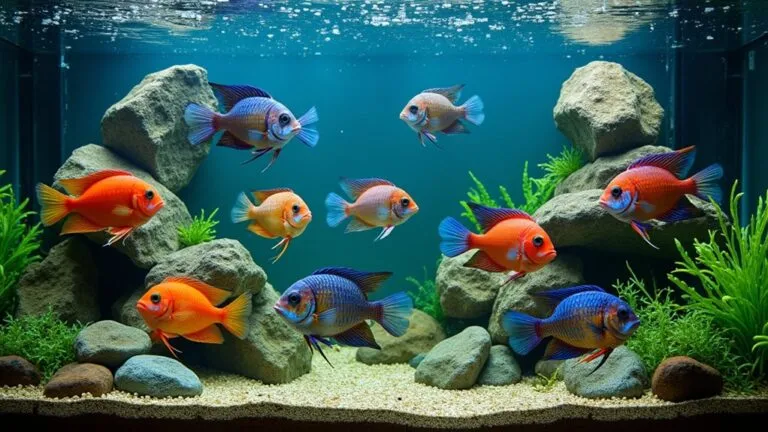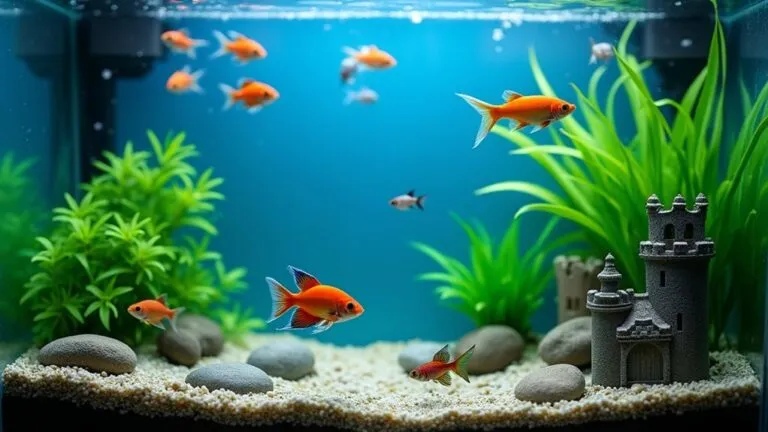Setting up your first aquarium can be a blast, especially when you pick the right beginner fish! Guppies are perfect for small tanks; they're hardy and come in vibrant colors. Neon tetras, with their cheerful schooling behavior, need to hang out in groups of six or more. If you're looking for bottom-dwellers, consider Corydoras catfish—they're peaceful and love to chill in pairs. Just remember to keep your fish's social needs and tank mates in mind to avoid drama, because nobody needs that! Stick around, and you'll uncover even more tips for creating a thriving underwater paradise!
Contents
- 1 Ideal Tank Size for Beginners
- 2 Top Beginner Fish Species
- 3 Choosing Community Fish
- 4 Fish Care and Maintenance
- 5 Feeding Guidelines for Beginners
- 6 Setting Up Your Aquarium
- 7 Compatibility and Stocking Tips
- 8 Common Mistakes to Avoid
- 9 Beginner-Friendly Fish Behavior
- 10 Resources for New Aquarists
- 11 Frequently Asked Questions
- 12 Final Thoughts
Ideal Tank Size for Beginners
When starting your aquarium journey, choosing the right tank size is crucial for your success. For beginners, a tank size of 10 gallons or more is recommended. This size gives you the space to house small fish comfortably, like tetras and guppies, while keeping water parameters stable.
You wouldn't want your fish to feel cramped, right? Proper tank size also helps maintain stable water temperatures and quality, which is essential for the health of your fish. In a 10-gallon tank, you can have a lovely community tank filled with small fish, ideally no larger than 2 inches each. This helps prevent overcrowding and ensures everyone has room to swim.
If you're looking to create a lively environment, consider adding schooling fish. They thrive in groups, and watching them swim together is a joy!
Of course, if you're feeling adventurous, larger tanks of 20-50 gallons open up even more possibilities. You can explore more species and create a balanced mix of top, middle, and bottom dwellers.
Just remember, more fish means more responsibility! For a sustainable approach, consider sustainable fish selection to minimize tank management stress.
Top Beginner Fish Species
Choosing the right fish species can make all the difference in your aquarium experience, especially for beginners.
You'll want to start with fish that are easy to care for and thrive in small freshwater setups. Guppies are a fantastic choice. These brightly colored little swimmers are hardy, making them perfect for those just starting out. They grow to about 2 inches, so they fit nicely in smaller community tanks. Maintaining proper water parameters such as pH and temperature is crucial for their health and well-being.
Next up are neon tetras. These vibrant fish grow to about 1-1.5 inches and love to hang out in schools of at least six. They're social creatures, and watching them swim together can be quite a show!
Don't forget about corydoras catfish. These peaceful bottom-dwellers help keep your tank clean and enjoy being in groups of at least five. Their charming antics will surely bring a smile to your face.
While you might be tempted by the beauty of bettas, they require a bit more attention.
Stick with guppies, neon tetras, and corydoras catfish for a lively, colorful, and harmonious aquarium that'll bring joy to both you and your aquatic friends!
Choosing Community Fish
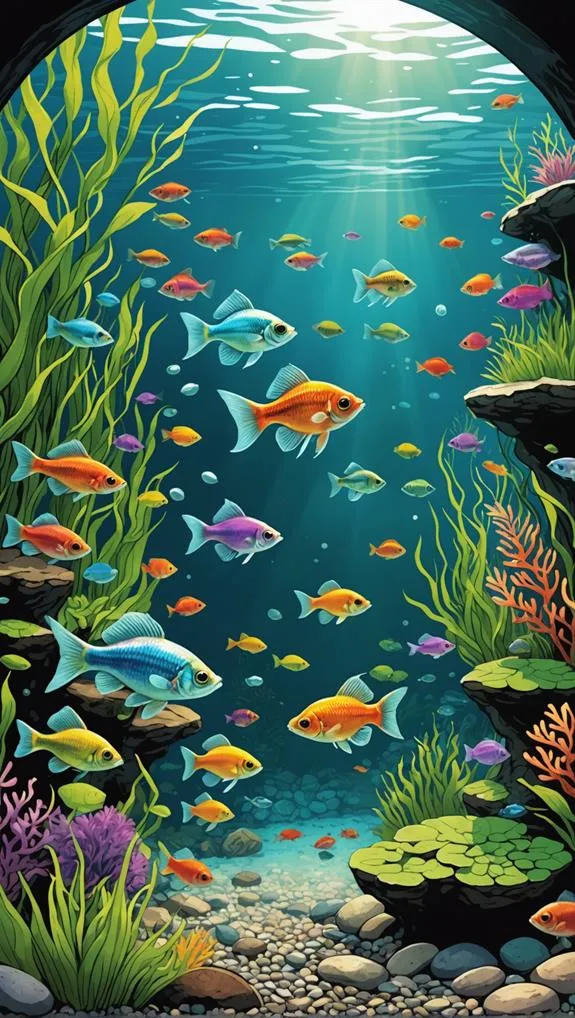
When you're picking community fish, it's super important to choose species that love to hang out in groups, like tetras and rasboras.
These little buddies not only feel happier together, but they also make your tank a lively place to watch.
Keeping an eye on your water quality is essential to ensure a healthy environment for your fish.
Just remember, you've gotta think about compatibility, too, so your fish can coexist peacefully without turning your aquarium into a soap opera!
Ideal Schooling Species
If you're setting up a community aquarium, selecting the right schooling species can make all the difference in creating a vibrant and harmonious environment.
Schooling fish like neon tetras and harlequin rasboras not only look stunning but also thrive in groups of six or more. They bring life to your tank while promoting peaceful interactions.
Here are three ideal schooling species to consider:
1. Neon Tetras: These little beauties prefer stable water conditions and do well with a pH of 7.0 to 7.8.
Their bright colors will light up any community tank!
2. Harlequin Rasboras: Known for their striking appearance, these guys also enjoy being in schools of six or more.
They're perfect for beginners and love to swim around happily.
3. Cherry Barbs: With their vibrant hues, Cherry barbs aren't just eye-catching; they thrive in groups too!
Keeping them in schools promotes their friendly nature, ensuring everyone gets along.
Compatibility With Tank Mates
To create a peaceful and thriving community aquarium, it's essential to ensure that your fish are compatible with each other. Imagine your tank as a little neighborhood—everyone needs to get along! Choose community fish like tetras, rasboras, and corydoras that share similar temperaments. These gentle swimmers will happily coexist, turning your aquarium into a harmonious space.
When picking tank mates, size matters too. Many small fish, such as guppies and tetras, grow to about 3 inches, making them perfect for smaller tanks.
It's also important to mix your swimmers! Combine top, middle, and bottom dwellers, like cherry barbs and corydoras, to maximize swimming space and reduce any territorial squabbles.
Don't forget about introducing dither fish like zebra danios! They can help calm any feisty neighbors, making your tank feel like a more stable community.
Keep an eye on your fish interactions; catching any signs of aggression early is key to ensuring everyone's health and happiness.
With a little care and attention, you'll create a beautiful, peaceful environment where your fish can thrive together!
Fish Care and Maintenance
Proper fish care and maintenance are crucial for keeping a thriving home aquarium. You want your aquatic friends to flourish, and that starts with a clean environment. Here are three key practices to keep in mind:
- Regular Water Changes: Aim for 10-15% water changes each week. This helps maintain water quality and prevents harmful toxins from sneaking in. Your fish will thank you!
- Monitor Water Parameters: Keep an eye on temperature, pH, and ammonia levels. Most easy-to-keep fish thrive within specific ranges, so checking these regularly is a must. It's like checking your kid's homework—better safe than sorry!
- Proper Filtration: Invest in a good filter to aerate the water and remove debris. A well-filtered tank reduces the need for extensive cleaning, making your life easier.
Also, don't forget about overfeeding! Feed your fish small amounts twice daily and remove any leftovers.
Lastly, if you're adding new fish, allow them a quarantine period of at least two weeks. This helps prevent diseases and gives them time to adjust. Happy fish-keeping!
Feeding Guidelines for Beginners
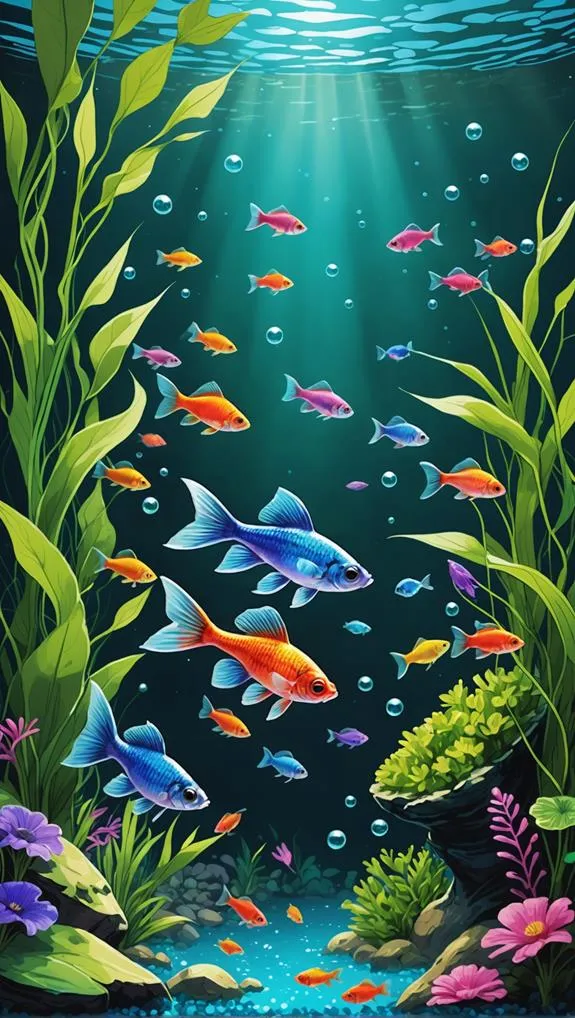
When it comes to feeding your fish, picking the right food is key to keeping them happy and healthy.
You'll want to choose high-quality flakes or pellets designed for their specific species, which makes mealtime a breeze.
Plus, remember to feed them small portions multiple times a day—trust me, they'll appreciate the buffet-style approach!
Proper Food Types
Feeding your fish a balanced diet is essential for their health and vitality. When you keep small fish in your aquarium, it's important to understand their specific care requirements.
A well-fed fish is a happy fish, and happy fish make for a lively aquarium!
Here are three key food types to consider:
- High-Quality Flakes or Pellets: Choose food specifically formulated for your fish species. This ensures they get the essential nutrients they need for growth and health.
- Live or Frozen Foods: Occasionally, treat your fish to live or frozen options like brine shrimp or bloodworms. This boosts their protein intake and encourages their natural foraging behavior—who doesn't love a little variety?
- Sinking Pellets for Bottom-Dwellers: If you have bottom-dwelling fish like Corydoras, they'll appreciate sinking pellets or wafers. This helps meet their unique nutritional needs.
Feeding Frequency Tips
Establishing a consistent feeding schedule is crucial for keeping your fish healthy and vibrant. As a beginner, you'll want to feed your fish once or twice daily. Just give them enough food to consume in 3-5 minutes. This helps prevent overfeeding and keeps your water quality in check.
For those small-sized fish like tetras and guppies, high-quality flakes or micro-pellets are perfect! They fit their dietary needs just right.
Don't forget to incorporate variety into their meals, too. Occasionally offering live or frozen foods like brine shrimp or bloodworms can spice things up and provide adequate nourishment.
Keep an eye on your fish behavior after feeding. If they're acting sluggish or leaving food uneaten, it could mean you're feeding too much or they're stressed.
Regularly adjust the amount of food based on how many fish you have and their growth. This ensures each little swimmer gets the nutrition they need without polluting the water.
Setting Up Your Aquarium
Setting up your aquarium can be an exciting yet daunting task, but with the right approach, you can create a thriving environment for your fish.
Start by choosing a tank that's at least 10 gallons; this gives your fish enough room to grow and helps maintain stable water conditions. Next, you'll want to install a reliable filter system. This crucial piece of equipment removes harmful toxins and keeps your water crystal clear.
Here are three essential steps to follow:
- Establish substrate and decorations: Use gravel or sand for bottom-dwellers and add plants or ornaments for hiding places. Your fish will appreciate a cozy environment!
- Cycle your aquarium: Before introducing any fish, allow beneficial bacteria to establish. This process prevents ammonia and nitrite spikes that can stress or harm your aquatic friends.
- Regularly test water parameters: Keep an eye on pH, ammonia, nitrite, and nitrate levels. A water testing kit can help ensure a healthy habitat.
Compatibility and Stocking Tips
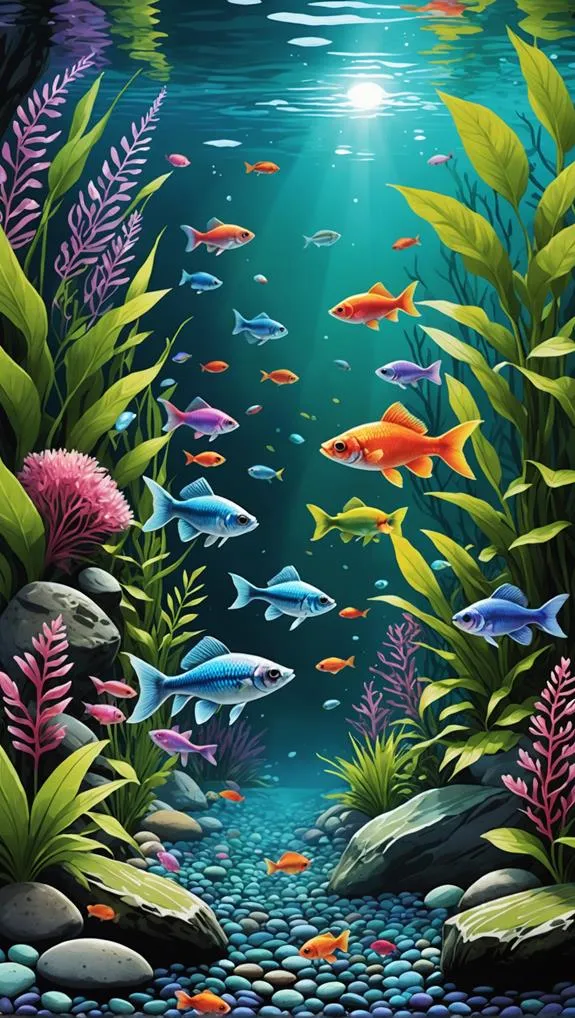
When you're choosing fish for your aquarium, it's crucial to think about their compatibility and social needs.
Most schooling fish, like neon tetras, love to hang out in groups, so aim for at least six to keep them happy.
Plus, keeping an eye on how your fish get along during those first few days can save you from unexpected tank drama!
Schooling Fish Requirements
Creating a thriving community aquarium with schooling fish requires careful consideration of their needs. These lovely creatures, like tetras and rasboras, thrive in groups of fish, so it's crucial to keep at least six together. This not only reduces stress levels but also makes your tank a lively, bustling habitat.
Here are three key tips to ensure a happy aquarium:
- Check Compatibility: It's vital to mix calm species with each other. Pairing aggressive fish with peaceful ones can spark territorial disputes, leading to a stressed environment.
- Know Adult Size: Be mindful of each species' adult size. Smaller fish, like neon tetras, grow only 1-1.5 inches, while larger schooling fish may need more space.
- Create a Balanced Community: Include both top and bottom dwellers in your tank to promote a healthy environment. This mix helps reduce competition for food and keeps everyone happier.
Aggression Management Strategies
Managing aggression in a community aquarium is vital for maintaining a peaceful environment. When stocking your tank, always observe size and temperament. Choosing peaceful species like tetras, rasboras, and guppies is a great start!
These little guys thrive in groups, so maintaining a proper group size—at least six individuals—will help them feel secure and less prone to aggression.
As you introduce new fish, do it gradually. This gives your established fish time to acclimate and reduces territorial disputes. Nobody likes an uninvited guest!
Providing ample hiding spots and swimming space is also essential. It allows less dominant fish to retreat, which can effectively manage aggressive behaviors.
Don't forget to monitor interaction closely. Keep an eye on your fishy friends, and be prepared to separate any that become overly aggressive or adjust your tank setup if necessary.
Remember, a happy aquarium means happy fish! By following these strategies, you can create a harmonious home for your aquatic companions.
Species Compatibility Guidelines
Successful fishkeeping hinges on understanding species compatibility and stocking tips. You want to create a harmonious underwater world for your fish. Here are three key guidelines to help you get started:
- Choose Compatible Species: Pair fish like neon tetras and guppies, which thrive in similar pH levels (7.0-8.0). This promotes a friendly environment for your tank mates.
- Maintain Proper School Sizes: Tetras and rasboras are social fish that feel safer in groups. Aim for at least six of each to help reduce stress and encourage their natural behaviors. No one likes feeling lonely, right?
- Watch for Aggression: Be cautious with aggressive fish, like Tiger Barbs. Keeping them in groups of six or more can help minimize their aggression towards others. Avoid mixing delicate fish, such as Betta males, with fin-nippers to keep everyone safe.
Also, don't forget to consider adult sizes when selecting your fish. Goldfish, for example, can grow up to 14 inches, requiring a bigger tank.
With these tips, you're well on your way to a thriving aquarium that serves both you and your aquatic friends!
Common Mistakes to Avoid
Often, beginners make several key mistakes when setting up their home aquarium that can jeopardize the health of their fish. One common blunder is overcrowding your tank. Freshwater fish need room to swim and establish territories, so always follow guidelines on tank size and fish compatibility.
Ignoring water parameters is another pitfall; neglecting pH levels or temperature can stress your fish out. Each species has specific needs, and meeting them is vital for their well-being.
Cycling your aquarium is crucial too. If you skip this process, harmful ammonia and nitrite spikes can occur, putting your fish at risk. Establishing beneficial bacteria before introducing your fish helps maintain water quality.
Don't forget about feeding errors! Overfeeding or sticking to just flake food can lead to health issues. Provide a balanced diet that includes a variety of options for your community or bottom-dwelling fish.
Lastly, be cautious when selecting tank mates. Incompatible species can cause aggression and stress, leading to high mortality rates. Doing your homework on fish temperament will help you keep a harmonious community tank that thrives!
Beginner-Friendly Fish Behavior

Understanding beginner-friendly fish behavior is crucial for creating a harmonious aquarium environment. When you choose peaceful fish like guppies or neon tetras, you set the stage for a stress-free community tank.
Here are three key behaviors to keep in mind:
- Schooling Fish: Neon tetras thrive in groups of six or more. Their social interactions help reduce stress and promote a lively atmosphere in your tank.
- Non-Aggressive Fish: Look for species that display peaceful behaviors. Corydoras catfish are great sociable bottom dwellers. They enjoy being in groups of at least three to six, and they help keep your tank clean by scavenging for leftovers.
- Monitoring Semi-Aggressive Tendencies: Some fish, like cherry barbs, can show semi-aggressive tendencies if not kept in adequate numbers. Aim for at least five or six to keep the peace.
Resources for New Aquarists
Starting your journey as an aquarist can feel overwhelming, but plenty of resources are available to help you navigate the waters.
First, visit your local tropical fish stores. They're gold mines of advice on species care and can help you set up the right tank for your new fishy friends.
Next, dive into online resources like blogs, videos, and care guides. These offer insights into dietary needs, social behaviors, and even compatibility between fish species. Knowing which fish can live together peacefully is crucial for a thriving aquarium environment.
Don't forget about community forums! They're fantastic places to connect with other fishkeepers. You can share tips, ask questions, or troubleshoot any issues you encounter. Trust me, someone else has probably faced the same challenge before!
Lastly, keep those care guides handy. They'll help you understand what each species requires to stay happy and healthy.
With all these resources at your fingertips, you'll gain confidence and knowledge, turning your aquarium into a beautiful underwater sanctuary. Happy fishkeeping!
Frequently Asked Questions
What Is the Best First Fish to Put in a New Aquarium?
When choosing your first fish, consider ideal fish species like guppies or neon tetras. Follow tank cycling tips, ensure fish compatibility, and think about choosing fish size to create a thriving community in your aquarium.
What Is the Best Fish Tank for a Beginner?
For your first aquarium, choose a minimum 10-gallon tank with a reliable filtration system. Consider substrate options, maintain proper water temperature, invest in a suitable lighting setup, and establish a consistent maintenance schedule for fish compatibility and health.
What Fish Is the Best for Beginners?
When choosing fish for beginners, consider community tank options like guppies or neon tetras. Ensure proper fish compatibility, maintain ideal water conditions, and follow feeding routines to avoid beginner mistakes and promote fish health.
What Is the Easiest Fish to Catch for Beginners?
When you're looking for easy catching techniques, consider popular beginner species like guppies or goldfish. Remember local fishing spots, use proper fishing gear basics, and practice catch and release methods to ensure fish thrive.
Final Thoughts
Starting your aquarium adventure can feel like diving into a colorful underwater world. By choosing the right beginner fish, keeping an eye on their needs, and avoiding common pitfalls, you'll create a thriving home for your finned friends. Picture vibrant fish swimming gracefully in a well-kept tank, bringing life and joy to your space. So, grab that net, have fun, and remember: every great aquarist was once a beginner just like you! Happy fishkeeping!
